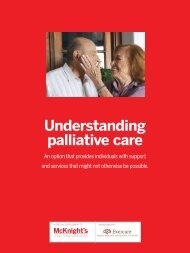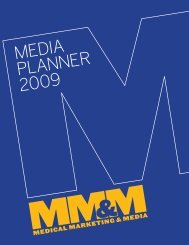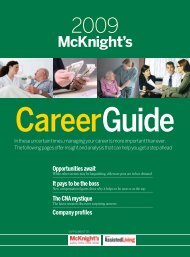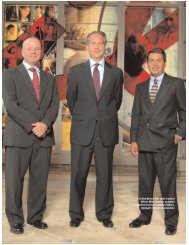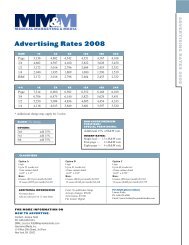RehabPerspectivesApril 2008 - Haymarket Media Group
RehabPerspectivesApril 2008 - Haymarket Media Group
RehabPerspectivesApril 2008 - Haymarket Media Group
You also want an ePaper? Increase the reach of your titles
YUMPU automatically turns print PDFs into web optimized ePapers that Google loves.
SUCCESSFUL REHAB MANAGEMENT IN LONG-TERM CARE<br />
RehabPerspectives<br />
April <strong>2008</strong><br />
Preparing for P4P:<br />
Do You Measure Up?<br />
Recruiting Staff<br />
Retaining Staff<br />
Partnering for Success<br />
SPECIAL ADVERTISING SECTION TO MCKNIGHT’S LONG-TERM CARE NEWS SPONSORED BY
R E H A B P E R S P E C T I V E S PREPARING FOR P4P: DO YOU MEASURE UP?<br />
P4P is Coming: Are You Ready?<br />
Whether it’s called P4P, pay for performance,<br />
or value-based purchasing, the focus<br />
is the same — the<br />
Centers for Medicare<br />
and Medicaid Services<br />
(CMS) wants<br />
value for its dollar.<br />
CMS is asking the<br />
question: How have<br />
you proved your<br />
worth lately?<br />
Traditionally Medicare<br />
based its spending<br />
on the cost of<br />
care. The first significant<br />
shift away from that kind of retrospective<br />
reimbursement came in 1999 with the prospective<br />
payment system (PPS), which created a per<br />
diem payment based on the acuity and resource<br />
utilization of the patient. Providers had to be<br />
prepared to talk about where they offered<br />
value. Then came quality indicators — public<br />
measures of nursing home quality.<br />
Now CMS will bring those and other quality<br />
measurements as benchmarks into the payment<br />
equation. It will hold providers accountable;<br />
payment will be based on value received. So how<br />
does facility A prove that it offers better value<br />
than facility B and how does it demonstrate to<br />
CMS that it offers more bang for the buck?<br />
This issue of Rehab Perspectives is Part 1 of<br />
three issues this year devoted to assessing how<br />
your facility measures up as pay for performance<br />
is implemented. We will focus on those<br />
areas that can make or break your success.<br />
As we at Aegis Therapies see it, the underpinning<br />
of most enterprises lies in human<br />
resources. Without the foundation of a good<br />
staff, your performance is mired in quicksand.<br />
In this issue, we explore the fundamentals of<br />
recruiting and retaining therapy staff. But we go<br />
a step further: we show you how a facility can<br />
collaborate with its therapy vendor to create a<br />
dynamic partnership that attracts and keeps the<br />
best therapists. It’s a recipe for excellence in<br />
patient care. That’s something CMS will be<br />
happy to pay for.<br />
As ever, Aegis is your rehab resource.<br />
Martha Schram<br />
President<br />
Aegis Therapies<br />
3<br />
5<br />
7<br />
Contents<br />
Wanted: Therapists<br />
Please, please, please apply!<br />
I Love My Job!<br />
Strategies for retaining staff<br />
Is Your Facility a Perfect Partner?<br />
How to help your vendor retain therapists<br />
RehabPerspectives<br />
For more information on these articles, contact AegisTherapies at:<br />
Aegis Therapies<br />
3960 Hillside Drive, Suite # 204<br />
Delafield, WI 53018<br />
Toll Free: (877) 877-9889<br />
Phone: (262) 646-5634<br />
www.aegistherapies.com<br />
Produced by McKnight’s Long-Term Care News<br />
K.T. Anders, Editor and Writer<br />
John O’Connor, Vice President, Associate Publisher/Editorial Director<br />
Sandra DiPasqua, <strong>Group</strong> Design Director<br />
Terry Rinella, Graphic Designer<br />
2<br />
SPECIAL ADVERTISING SECTION TO MCKNIGHT’S LONG-TERM CARE NEWS
R E H A B P E R S P E C T I V E S PREPARING FOR P4P: DO YOU MEASURE UP?<br />
Wanted: Therapists<br />
Bill Goulding’s 27-year-old daughter, Kate Cushman, has huge<br />
expectations as she prepares to enter the labor force. She’s<br />
completing her doctorate in physical therapy, and her professors,<br />
and even her father, who is national director of outcomes and<br />
reimbursement for Aegis Therapies, have assured her that she can<br />
pretty well write her own ticket in terms of location, benefits, salary,<br />
and perks.<br />
What’s so special about Kate? She’s a scarce commodity — she’s a<br />
therapist. Right now, a tight labor market doesn’t even begin to<br />
describe the dearth of therapists in all disciplines across the country.<br />
“There’s a shortage, so there’s an entitlement mentality for therapists<br />
at every level,” says Goulding. “We have 20-some recruiters around<br />
the country and we do density studies to determine how many therapists<br />
are licensed in the state. In some places there are only 11 OT<br />
assistants in the whole state. How do you compete for hires?”<br />
It’s a question long term care facilities ask themselves every day.<br />
Not only is the pool tiny, but geriatric rehab is not always the venue<br />
of choice for new grads. As Kate and her contemporaries contemplate<br />
the array of providers nationwide, what will influence their<br />
choice? How does a company become the lucky employer?<br />
Creative Recruiting<br />
A booth at the job fair and a pretty brochure might pull in tennis<br />
pros and insurance adjustors, but in the therapy world, it takes a bit<br />
more. Recruiting is a cutthroat sport. Pirating is not unknown. “We<br />
are fiercely challenged on a daily basis and never have access to<br />
enough people,” says Liz Grima, senior vice president of Human<br />
Resources for Golden Innovations. “Therapists probably get five to<br />
10 pieces of direct mail every week asking them to change jobs. They<br />
are being cold-called at home and even at work. Internet job boards<br />
have thousands of employment opportunities.”<br />
To reach those plum employees, a company or provider has to<br />
climb higher than the pack. A first step, of course, is visibility in all<br />
the normal recruiting venues — booths at professional association<br />
meetings, ads in professional journals, online ads at job sites such as<br />
Monster.com.<br />
Direct mail is probably the most common way to try to snare<br />
prospects. Of course, it’s not simple, nor is it inexpensive. “We carefully<br />
tailor our direct mail campaign,” says Grima. “We target various<br />
interests, such as therapists who are looking to reenter the industry,<br />
those who want to work part-time, or who are looking for careers<br />
in clinical management. You have to be able to scratch people where<br />
they itch.”<br />
But with all companies and providers fishing the same pond, it takes<br />
Please, please, please apply!<br />
3<br />
SPECIAL ADVERTISING SECTION TO MCKNIGHT’S LONG-TERM CARE NEWS<br />
The competition for good therapists has perhaps never been keener. That's why firms<br />
hoping to land top therapists need to recruit and reward effectively, experts say.
R E H A B P E R S P E C T I V E S PREPARING FOR P4P: DO YOU MEASURE UP?<br />
Employee referrals are one of the best ways for companies to learn about qualified<br />
therapists who may be available for employment in the long-term care market.<br />
some out-of-the-box thinking to reel in a catch. The number one<br />
source for new employees for Aegis is employee referral, according to<br />
Donna Coyle, employment manager for Aegis Therapies. “There’s<br />
nothing better than a satisfied employee encouraging someone else to<br />
work here,” she says. “We call it Bucks for Buddies. Our associates<br />
receive a bonus if they refer someone and they are still employed when<br />
the person completes the 90-day probation period. Happy associates,<br />
who feel valued, are a walking billboard for the company.”<br />
Recruiters have always targeted graduating seniors, but holding<br />
the pitch until the sheepskin is in hand may be waiting too long. “We<br />
begin a little earlier,” says Kay McCall, vice president of recruitment<br />
for Aegis. “Universities don’t always focus on long term care as an<br />
employment environment. We are aggressive in talking to students<br />
in their first, second, and third year at university, not just those ready<br />
for the job market. Our district managers and clinical managers<br />
make presentations, not about Aegis, but about long term care, the<br />
benefits of the geriatric setting, and the rewards of serving those<br />
patients. We try to dispel the myths about long term care and create<br />
enthusiasm for this fulfilling venue.”<br />
Enticing students with hands-on experience is a subtle way to<br />
build enthusiasm for a company. For example, Aegis has developed<br />
clinical affiliations with universities so students can do their forcredit<br />
rotations with Aegis. “They see us walk the talk,” says McCall.<br />
“They can experience the kind of support, education, and equipment<br />
we have and see the progress patients make. It clarifies opportunities<br />
in our setting and increases the chances that they will<br />
become our employees when they graduate.”<br />
The Employment Package<br />
With so many companies and facilities to choose from, prospective<br />
employees look hard at what companies offer. The foundation of an<br />
attractive employment package is the reputation of the company or<br />
facility. “Being known as a quality clinical organization is a strong<br />
lure,” says McCall. “A company that puts patients first, has clinical<br />
depth, and takes care of their customers is attractive to people seeking<br />
a job and thus attracts the best applicants.”<br />
It’s best not to leave the creation of the employment package to<br />
chance. For example, to find out what therapists really want, Aegis<br />
conducts focus groups around the country, quizzing new grads on their<br />
ideal job. “Basically, they want a company that takes care of them,”<br />
reports McCall. “They want mentoring — they want to be successful<br />
and see that they can make a difference. They want to be groomed.<br />
They want flexibility. And of course they want good compensation.”<br />
For therapists who have spent 6 1 ⁄2 years in school, compensation can<br />
4<br />
SPECIAL ADVERTISING SECTION TO MCKNIGHT’S LONG-TERM CARE NEWS<br />
be crucial. In exchange for employment agreements, Aegis offers postgraduate<br />
student-loan programs to help repay schooling costs. And to<br />
keep salaries competitive, the company conducts research and factors<br />
in cost of living adjustments. Aegis also sweetens the financial picture<br />
with a monetary allowance for continuing education, as well as for<br />
professional association dues and licensure renewal. Benefits for full<br />
time employees begin the first month after employment.<br />
But money isn’t everything. The 21st century therapist, unlike the<br />
work-driven post-Depression boomer, values a balance between<br />
work and life. Proximity to their homes, flexible time schedules, and<br />
even job sharing, where two or three people can fulfill one full-time<br />
position, are very important, particularly to women with children.<br />
Often potential employees ask about the activities that are available.<br />
Is there a softball team? What do employees do as a group? “We<br />
value a work-life balance and promote it in our recruitment,” says<br />
McCall. “Our overall goal is to have a well-rounded employee.”<br />
But it’s perhaps the promise of a career ladder, clinical support,<br />
and quality clinical programs that really seal the deal. “Therapists<br />
tend to be idealistic,” says Coyle. “They got into the field to make a<br />
difference in lives. An employer who gives them innovative clinical<br />
programs that show results is going to be enormously attractive.”<br />
Recruiting for the Future<br />
Finding therapists today is one thing, but what about tomorrow?<br />
The current shortage of therapists does not bode well for the future.<br />
As the boomers move into the healthcare arena, the demand for<br />
therapists will continue to grow. “We have to develop our own<br />
workforce,” says Grima. “We’ve got to get into middle schools and<br />
high schools to get kids excited about therapy. I call it relationship<br />
recruiting. It’s all about establishing relationships. An individual<br />
may not be ready for the job now, but when the time comes, I want<br />
my company to be on the top of the list.”<br />
Recruiting is no easy task. It takes massive resources, an enormous<br />
investment in time, and real imagination to meet employee expectations.<br />
“Whatever is important to that therapist – such as having the<br />
flex time to run out to pick up their child at school – if we can make<br />
it work, we let them know we can do it,” says McCall.<br />
Of course, in the employment game, winning the new hire is not<br />
the end of the story. Next comes figuring out how to beat back the<br />
pirates from stealing your therapist away. Read on. ■<br />
What Applicants Say<br />
Based on focus groups conducted by Aegis Therapies, here is what therapists<br />
say they are looking for:<br />
What attracts you to a company or facility?<br />
• Recommendation of friends<br />
• Salary and bonuses<br />
• Excellence in clinical programs<br />
• Enjoyable internship<br />
• Promise of on-site clinical fellowship<br />
• Clinical reputation<br />
• CEUs<br />
• Nationwide company<br />
• Promise of continuing training<br />
What makes you decide to work for a specific company or facility?<br />
• Compensation<br />
• Clinical Setting<br />
• Location of position<br />
• Continuing Education<br />
• Flexibility<br />
• Career Opportunities<br />
• Mentorship/Support • Benefits
R E H A B P E R S P E C T I V E S PREPARING FOR P4P: DO YOU MEASURE UP?<br />
I Love My Job!<br />
Donna Diedrich, PT, GCS, is a happy employee. She has been<br />
a therapist with the same company for 13 years. Oh, there<br />
were those four months when the grass looked greener and<br />
she was wooed away by another company. “I call it a hiatus,” she<br />
confesses sheepishly. But things didn’t work out. “The new company<br />
didn’t share my values or have the clinical programs or the support<br />
I was used to. I realized I’d made the wrong decision.” So Donna<br />
returned to her original company and remains there today. “I’ve had<br />
no reason to leave,” she says.<br />
On several levels, Donna’s story is an example of good staff retention<br />
strategies. She and the company were a good fit philosophically;<br />
they shared the same standards and patient focus. “I don’t look<br />
for all my compensation in my paycheck,” says Diedrich. “When I<br />
look at all I’ve gained in 13-plus years with the company, I see the<br />
opportunity for professional growth and the ability to pursue my<br />
specialization and to rise in my career track. I’m also grateful I was<br />
given the flexibility to step back and take care of my family during<br />
the years I needed to do that.”<br />
Donna Diedrich found her niche at Aegis Therapies, and she is now<br />
a regional director of clinical services. Currently she is one of several<br />
Aegis employees who have been granted a scholarship to pursue their<br />
Clinical Doctorates (DPT) at Rocky Mountain University. “Aegis has<br />
given me the chance to remain competitive in the field,” she says. “It’s<br />
a commitment to their investment in me. I’m proud of where I work.”<br />
That pride and loyalty is the ultimate goal of every employer. It’s particularly<br />
tough to achieve when competition for employees is intense.<br />
Here are some strategies that will keep employees happy at the ranch.<br />
Clinical Strength<br />
Job satisfaction creates stable employees. “One of the keys to retaining<br />
staff is creating a clinically rewarding environment,” says Mark Besch,<br />
vice president of clinical services of Aegis Therapies. “Programs that<br />
are on the cutting edge clinically are going to keep therapists excited<br />
and enthusiastic about their work.” Core and specialty programs that<br />
address specific geriatric patient needs, such as dementia, continence,<br />
care for the medically complex, and fall prevention, allow therapists to<br />
learn specific strategies for successful treatment. Incorporating current<br />
research into treatment, such as Aegis has done with its modalities program<br />
and its Nautilus strength-building programs, gives therapists<br />
strong tools that will yield the best outcomes.<br />
Ongoing Education<br />
Continuing education units (CEUs) are essential for therapists to<br />
maintain their licensure. However, warns Bill Goulding, national<br />
Strategies for retaining staff<br />
5<br />
SPECIAL ADVERTISING SECTION TO MCKNIGHT’S LONG-TERM CARE NEWS<br />
One of the keys to retaining staff is establishing a clinically rewarding environment.
R E H A B P E R S P E C T I V E S PREPARING FOR P4P: DO YOU MEASURE UP?<br />
director of outcomes and reimbursement for Aegis Therapies, external<br />
CEUs can be pricey compared to the value received. “An employer’s<br />
dollars will fly out very quickly if the definition of keeping staff<br />
happy is to send them out to conferences and workshops,” he says.<br />
“Offering internal seminars and web-based education is not only<br />
more economical, but more convenient for employees, who often can<br />
access e-learning and web-based courses from their homes.”<br />
But obtaining CEUs is only the beginning of ongoing training. “It’s<br />
important to train therapists to be successful with the population<br />
they want to work with,” says Besch. “The dementia population is a<br />
perfect example. Not many new grads come out of school well<br />
equipped to deal with patients with dementia. The therapist who<br />
treats patients with Alzheimer’s is not going to be happy if he or she<br />
can’t be successful. So we train therapists on strategies for intervention<br />
for patients with dementia. We have an assessment process to<br />
estimate the level of cognitive ability. Given the right tools, therapists<br />
are going to enjoy their jobs and hang around longer.”<br />
Mentorship and Clinical Support<br />
Imagine a therapist whose patient is not making progress. Who will<br />
help him or her noodle solutions or discover what other therapists<br />
have done? The ability to share with peers and tap into a hierarchy<br />
of expertise is a precious resource.<br />
“To know you can pick up the phone and talk about a patient in a<br />
non-threatening, nonjudgmental, peer-to-peer “can-you-help-mesolve-this”<br />
way is invaluable,” says Diedrich. In fact, clinical support<br />
is another reason she isn’t interested in changing jobs.<br />
As a master clinician, Diedrich is one of a group of therapists within<br />
the company who are ready to answer questions about their specialized<br />
skill set within their own disciplines, such as orthopedics,<br />
wound intervention, dementia, or even wheelchair positioning or<br />
splinting. But she’s only one layer of clinical help available. Aegis’<br />
larger facilities have regional program coordinators in the facility.<br />
Smaller facilities have clinical specialists and regional program managers<br />
in charge of the overall clinical programs. “All of our district<br />
managers, regional vice presidents, and area directors are clinicians,<br />
so they can talk about clinical issues all day long,” says Diedrich. “It’s<br />
a clinical depth that is available anytime to the therapist on the floor.”<br />
The best employers listen to what their employees have to say. For those who want<br />
to be seen as an employer of choice, the key is getting engagement from workers.<br />
6<br />
SPECIAL ADVERTISING SECTION TO MCKNIGHT’S LONG-TERM CARE NEWS<br />
Career Tracks<br />
Bill Goulding remembers the not-so-good-old days when a therapy job<br />
was a dead end. “When I started as a therapist, that’s what you were,<br />
there was no career track,” he recalls. “Today, therapy is a business that<br />
offers a future. While some therapists want to be the best darned therapist<br />
they can be, others want a chance to rise within the ranks.”<br />
Opportunities for increased areas of responsibility and scope make<br />
remaining for the long haul with one employer attractive. In contrast<br />
to the traditional method of climbing the career ladder into operations<br />
and management positions, therapists often prefer a structure of<br />
advancement within the clinical arena. Positions such as clinical<br />
leaders who train others, or clinical managers with responsibility over<br />
therapists in several buildings, keep therapists engaged clinically<br />
while still moving upward in their careers.<br />
Career identity is enhanced when employees perceive the importance<br />
of their jobs in the larger context of the industry as a whole.<br />
Encouraging participation in professional associations and even<br />
involving employees in grassroots industry advocacy by creating web<br />
links for comments on issues before state legislators are simple<br />
tactics that put therapists into the big picture.<br />
Technology<br />
Paperwork is a thorn in the side of most therapists. The burden,<br />
however, can be lightened with an investment in technology.<br />
Sophisticated computer programs that facilitate entering and tracking<br />
information and an outcomes program that can measure<br />
improvement are a few ways to get the therapist away from the desk<br />
and back to the patient as quickly as possible, thus adding to job<br />
satisfaction. Time away from the patient is more productive if therapists<br />
have convenient computer access to professional organizations<br />
and various research sources, as well as the ability to key into<br />
clinical programs and billing information.<br />
Recognition<br />
Everyone wants to be appreciated. Making employees feel valued is<br />
an ongoing challenge. “We have several formal and informal programs<br />
to recognize excellence,” says Christy Ickes, senior director of<br />
human resources for Aegis Therapies. Incentives, such as Employee<br />
of the Quarter, single out those who go above and beyond in their<br />
work. ACE awards, given for appreciation, compassion, and excellence,<br />
can be redeemed toward purchases online. “We’ve received<br />
good feedback on these recognition programs and continually strive<br />
to show our appreciation to our employees,” says Ickes.<br />
Satisfaction surveys<br />
The best employers listen to what their employees say. Yearly anonymous<br />
employee satisfaction surveys take the pulse of the workforce.<br />
“It takes a company that is deeply committed to employee satisfaction<br />
to retain therapists,” says Ickes. “Surveys can actually tell us<br />
how to make the workplace better and the feedback drives change<br />
within the company.” She cites one survey that resulted in the creation<br />
of a newsletter and a regional website where employees could<br />
share successes, post stories, and celebrate recognition. “Employees<br />
told us they wanted more communication,” she says. “Surveys also<br />
prompted us to create a short-term disability program, an employee<br />
assistance program, and enhanced wellness benefits.”<br />
It takes a concerted, ongoing effort to become an employer of<br />
choice. Without job satisfaction, the grass will always look greener.<br />
“What keeps employees happy is engagement, how they are cared<br />
for, and what investment is made in them,” says Liz Grima, senior<br />
vice president of human resources for Golden Innovations. “That’s<br />
what keeps people motivated to come to work.” ■
R E H A B P E R S P E C T I V E S PREPARING FOR P4P: DO YOU MEASURE UP?<br />
Is Your Facility a<br />
Perfect Partner?<br />
How to help your vendor retain therapists<br />
“<br />
Idon’t want to work in this facility any more.” In a market<br />
where therapists are as scarce as sunshine in a snowstorm,<br />
these words are a therapy manager’s worst nightmare.<br />
No matter how diligently the therapy vendor tries to keep its therapists<br />
happy, the truth is that job satisfaction really boils down to<br />
what happens when the therapist walks through the door of the<br />
facility. “Therapists don’t see the therapy company that hired them<br />
when they walk into work,” says Beth Hoblit, regional vice president<br />
for Aegis Therapies. “They see the facility — the building, the staff,<br />
the patients. If they don’t like the atmosphere and environment, they<br />
aren’t going to want to work there.”<br />
The vendor may sign the paychecks, but it’s the facility that is on<br />
the line as the place of work. Vendor and facility must join hands to<br />
create a good working environment. “It’s so difficult to find therapists<br />
that you cannot leave it completely up to the vendor,” says Bill<br />
Goulding, director of outcomes and appeals management for Aegis<br />
Therapies. “It’s got to be a partnership.”<br />
That partnership begins with the reputation and quality of the<br />
facility. Therapists may feel great about the care they provide, but if<br />
they see patients who are poorly dressed, with bandages that have<br />
not been changed, or with pressure sores, then they perceive that<br />
patients are at risk and it’s uncomfortable to work there.<br />
The American Baptist Homes of the West (ABHOW) are good<br />
examples of the therapy/facility partnership. “We know that our<br />
facilities have an important part to play in therapy staff recruitment<br />
and retention,” says Jeff Glaze, senior vice president and chief operations<br />
manager for ABHOW. “It shows in the quality of the buildings<br />
we have and the way our staff interacts with the therapists.<br />
Everybody recognizes that we are all together in taking care of our<br />
residents, so we include our partners in our care plans.”<br />
The partnership at ABHOW exists on every level. Hoblit relates this<br />
example of the just how well an executive director at one of the<br />
American Baptist Homes of the West understood the concept: “My<br />
district manager invited the executive director of a facility to lunch<br />
and asked, ‘What can I do for you?’ But the executive director said,<br />
‘No, I’m paying for lunch, and I want to know what I can do for you.’”<br />
Creating the Team<br />
In job-satisfaction focus groups conducted by Aegis Therapies, therapists<br />
said it was important for them to feel part of the facility’s staff.<br />
Rather than being perceived as a vendor, the rehab program coordinator<br />
should be seen as a department head. Therapists need to be<br />
included as team members in all elements of patient care, including<br />
weekly stand-up meetings, resident reviews, and the facility’s execu-<br />
7<br />
SPECIAL ADVERTISING SECTION TO MCKNIGHT’S LONG-TERM CARE NEWS<br />
tive director meetings. Good communication between nursing and<br />
therapy is crucial. Are expectations and goals shared? Are therapists<br />
notified when patients are admitted or scheduled for discharge?<br />
“Our therapists are welcomed as part of the team,” says Glaze.<br />
They don’t feel like Aegis employees, they feel like facility employees.<br />
Generally Aegis has therapists lined up to come into our buildings<br />
because they find the work environment so attractive.”<br />
One of the biggest obstacles to creating the team-work environment<br />
is time. “Everyone gets very busy and its easy to get focused on<br />
your little piece of it without recognizing that there are others who<br />
would benefit from the information or assessment you have on the<br />
resident,” adds Glaze. “Providers need to reach out to their vendor<br />
therapists. After all, no one wins when a therapist leaves his job.”<br />
It doesn’t take much to make therapists feel appreciated. Wearing<br />
a facility nametag, for example, rather than a vendor nametag, clearly<br />
identifies therapists as part of the facility. But it doesn’t take much<br />
to send the opposite message either. “I’ve worked in facilities where<br />
therapists working full time in the building were not invited to the<br />
Christmas party,” recalls Goulding. “That’s a clear statement that<br />
you are not one of ‘us.’”<br />
“Therapists crave teamwork mentality and clearly stated goals for<br />
outcomes,” says Hoblit. She stresses that a facility that partners with<br />
its therapy vendor, is good at communication, and good at measuring<br />
and facilitating the team spirit will retain therapists. “Given that,<br />
therapists will stay until the day they retire.” ■<br />
The Partnership Quiz<br />
Yes No Does a representative from management greet and welcome<br />
prospective therapy hires when they come to visit the facility?<br />
Yes No Is the therapy room and equipment well maintained?<br />
Yes No Do therapists feel they are part of the care team?<br />
Yes No Is the rehab coordinator considered a department head?<br />
Yes No Are therapists included in staff parties, social events and<br />
recognition events?<br />
Yes No Do therapists wear the name tags of the facility?<br />
Yes No Is there good, friendly communication between therapy and<br />
nursing, with sharing of goals and progress reports?




